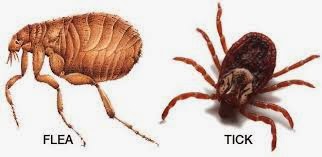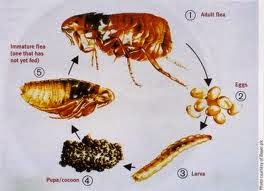
Anyone who has suffered through an infestation of fleas knows these parasites are programmed for survival. In ideal conditions, fleas can complete their life cycle in just 12 days, adding thousands of new offspring. Understanding how to control this life cycle and killing adult fleas helps your pet – and your home – remain flea-free!

Flea Myths
Flea Myth #1: Fleas go away during winter months.
Although a good part of the country sees a decrease in flea cases during colder months, fleas can survive by taking advantage of our human comforts. Fleas thrive at temperatures above 65 degrees, making our homes a perfect winter refuge. The cocoon stage can actually survive up to five months in cooler temperatures – allowing the next generation of fleas to hatch and attack our pets in the spring!
Flea Myth #2: Natural remedies like brewer’s yeast and garlic are safe and effective flea control methods.
For many pet owners, avoiding man-made chemicals and “going green” is important. Garlic, for example, is purported to kill fleas, but the only study conducted showed no effect. Organic and natural remedy products are not only often ineffective at controlling fleas, but sometimes even cause illness in pets.
Flea Myth #3: Chemical pesticides are harmful to pets and to the environment.
Historically, this is true! The Environmental Protection Agency (EPA) banned products containing organophosphates like Diaz anon due to cancer risks and environmental impact. Advances in pest control provide us environmentally safe products that can be used on pets. Your family veterinarian has both oral and topical products providing effective and immediate flea kill. Additionally, these products are harmless to both pets and children.
Flea Myth #4: Fleas are resistant to these new chemicals – even products my veterinarian carries.
With stories of “super-bug” bacteria making headlines, it’s easy to imagine a super flea shaking off pesticides like water. Veterinary products have a great track record of killing fleas and experts state resistance to these products has not occurred. Most perceived product failures are likely due to excessive numbers of fleas or inappropriate application.
Flea Myth #5:
There is no difference between flea products purchased from big box stores and your veterinarian. Sometimes it is the same product and sometimes it is not. Unfortunately, this myth is the cause of many emergency room visits – and pet deaths. Grocery store products may contain older insecticides and chemicals. This could mean that they are simply less effective, but in some cases, these products have actually killed pets – especially cats. In an attempt to save money, well-meaning owners have used dog products on their cats, causing the cat to seizure uncontrollably – creating a potentially fatal emergency.
Tick Myths
Tick Myth #1
My dog lives in the city so it won’t get a tick.
Brown dog ticks are an urban tick that can live the entire life cycle indoors at the pet store, boarding facility your home or the groomer. Your dog can get a tick even if it never sets foot outside. This is why veterinarians advise the year-round application of tick and flea preventative.
Tick Myth #2
Ticks do not survive the winter.
Some species of ticks are able to go for 12 months without a blood meal. Lyme disease ticks (Eastern and Western Black-legged ticks) feed on animals as a larva, nymphs, and adults. Larva prefers small mammals such as mice. Nymphs and adults prefer large mammals such as deer dogs and humans. Nymphs are known to survive in the cold New England winter. In fact, if you do see a tick outdoors between September and March it is highly likely that it is a Lyme disease spreading tick.
Tick Myth #3 Ticks transmit disease as soon as they touch your pet.
Ticks can’t transmit bacteria until they have cemented their mouthparts into the skin. This takes about 4 hours. They don’t transmit Lyme disease bacteria until they have had a blood meal about 24-48 hours. By then the Borrelia bacteria (the Lyme disease organisms) have changed their surface proteins and enter the mammal’s body.
Ticks can transmit within just 15 minutes after biting a virus that is capable of causing encephalitis in people.
Your veterinarian has access to at least ten non-toxic flea and tick products. Your veterinarian can recommend what’s best for your dog or cat. Since the Brown dog tick is capable of spending its entire life indoors it’s best to use the product every month year round.
Don’t leave your pet’s comfort and your safety in the hands of someone who doesn’t know your pet – see your veterinarian for the best advice on avoiding flea and tick infestation!








